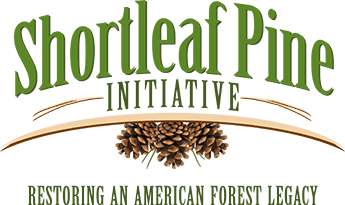|
Shortleaf research, newspaper articles, fact sheets, conference proceedings, literature reviews, and brochures.
Literature LibraryHuebschmann, M. M., Tilley, D. S., Lynch, T. B., Lewis, D. K., & Guldin, J. M. (2002). Economic evaluation of restoring the shortleaf pine-bluestem grass ecosystem on the Ouachita National Forest. Southern Research Station, General Technical Report SRS-48. Retrieved from http://www.treesearch.fs.fed.us/pubs/3149  Effect of dissolved oxygen concentration on the relative susceptibility of shortleaf and loblolly pine root tips to Phytophthora cinnamomi
Effect of dissolved oxygen concentration on the relative susceptibility of shortleaf and loblolly pine root tips to Phytophthora cinnamomi
Fraedrich, S., & Tainter, F. (1989). Effect of dissolved oxygen concentration on the relative susceptibility of shortleaf and loblolly pine root tips to Phytophthora cinnamomi. Phytopathology, 79(10), 1114-1118. Retrieved from http://www.apsnet.org/publications/phytopathology/backissues/Documents/1989Articles/Phyto79n10_1114.PDF  Effect of prescribed burns and shelterwood cutting on reproduction of shortleaf and Pitch Pine
Effect of prescribed burns and shelterwood cutting on reproduction of shortleaf and Pitch Pine
Little, S., & Moore, E. (1950). Effect of prescribed burns and shelterwood cutting on reproduction of shortleaf and Pitch Pine. Northeastern Forest Experiment Station, Station Paper (35). Retrieved from https://www.nrs.fs.fed.us/pubs/sp/sp_ne035.pdf Sabatia, C. O., Will, R. E., & Lynch, T. B. (2009). Effect of thinning on aboveground biomass accumulation and distribution in naturally regenerated shortleaf pine. Southern Journal of Applied Forestry, 33(4), 188-192. Retrieved from http://www.ingentaconnect.com/content/saf/sjaf/2009/00000033/00000004/art00006  Effect of Thinning on Partitioning of Aboveground Biomass in Naturally Regenerated Shortleaf Pine (Pinus Echinata Mill.)
Effect of Thinning on Partitioning of Aboveground Biomass in Naturally Regenerated Shortleaf Pine (Pinus Echinata Mill.)
Sabatia, C. O. (2007). Effect of Thinning on Partitioning of Aboveground Biomass in Naturally Regenerated Shortleaf Pine (Pinus Echinata Mill.). Proceedings of the 14th biennial southern silvicultural research conference. Gen. Tech. Rep. SRS–121. Asheville, NC: U.S. Department of Agriculture, Forest Service, Southern Research Station. 577-578. Retrieved from https://www.srs.fs.fed.us/pubs/gtr/gtr_srs121/gtr_srs121_577.pdf Cain, M. D., & Shelton, M. G. (2003). Effects of Alternative Thinning Regimes and Prescribed Burning in Natural, Even-Aged Loblolly–Shortleaf Pine Stands: 25 Year Results. Southern Journal of Applied Forestry, 27(1), 18-29. Retrieved from http://www.ingentaconnect.com/content/saf/sjaf/2003/00000027/00000001/art00003 Williams, R.A. (1998) Effects of fire on shortleaf and loblolly pine reproduction and its potential use in shortleaf/oak/hickory ecosystem restoration. Proceedings of the Ninth Biennial Southern Silvicultural Research Conference. Gen. Tech. Rep. SRS-20. Asheville, NC: U.S. Department of Agriculture, Forest Service, Southern Research Station, p. 321-325. Retrieved from https://www.srs.fs.usda.gov/pubs/gtr/gtr_srs020/index.htm Phillips, R. J., Waldrop, T. A., Chapman, G. L., Mohr, H. H., Callaham, M. A., & Flint Jr, C. T. (2004). Effects of fuel-reduction techniques on vegetative composition of Piedmont Loblolly-Shortleaf pine communities: preliminary results of the National Fire and Fire Surrogate Study. Southern Research Station, General Technical Report SRS-71. Retrieved from http://www.srs.fs.usda.gov/pubs/viewpub.php?index=6603 Hallgren, S., & Tauer, C. G. (1987). Effects of Lift Date, Storage, and Family on Early Survival and Root Growth Potential of Shortleaf Pine. Proceedings, Intermountain Forest Nursery Association; 1987 August 10-14; Oklahoma City, OK. General Technical Report RM-151. Fort Collins, CO: U.S. Department of Agriculture, Forest Service, Rocky Mountain Forest and Range Experiment Station: 87-92. Retrieved from https://rngr.net/publications/proceedings/1987/hallgren2.pdf/?searchterm=None  Effects of precommercial thinning in naturally regenerated loblolly-shortleaf pine stands in the upper west gulf coastal plain: results after two growing seasons
Effects of precommercial thinning in naturally regenerated loblolly-shortleaf pine stands in the upper west gulf coastal plain: results after two growing seasons
Guldin, J. M., & Shelton, M. G. (2010). Effects of precommercial thinning in naturally regenerated loblolly-shortleaf pine stands in the upper west gulf coastal plain: results after two growing seasons. Southern Research Station, General Technical Report SRS-121. Retrieved from https://www.srs.fs.fed.us/pubs/gtr/gtr_srs121/gtr_srs121_055.pdf |

